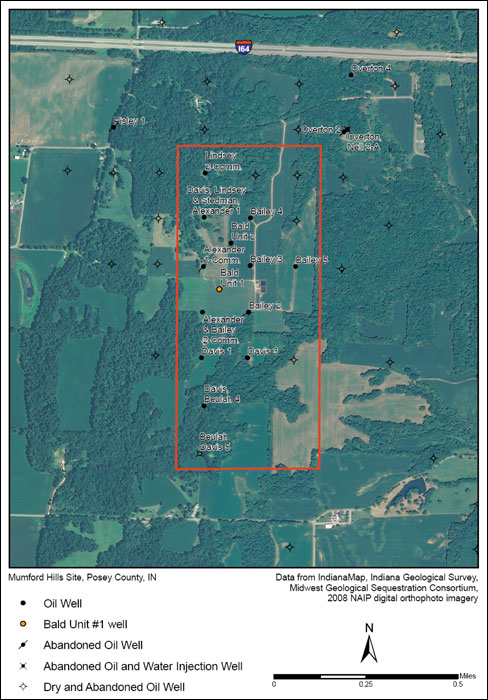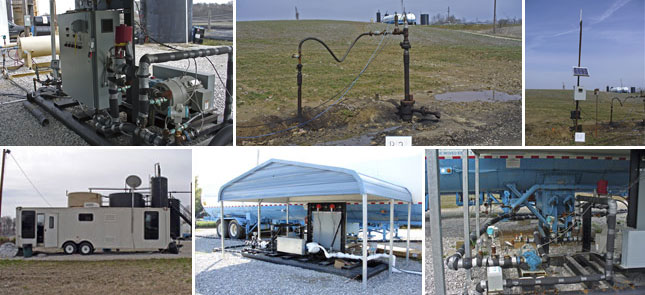EOR II pilot — Mumford Hills Oil Field, Indiana
This miscible liquid CO2 pilot is designed to inject CO2 into a prevalent Illinois Basin oil-bearing interval (or equivalent) to directly measure CO2 sequestration mass, enhanced oil recovery, and CO2 injection rate. The Clore Formation, an oil-bearing interval similar to the Cypress Sandstone, was chosen as the target formation. Numerical modeling will be used to assess EOR and sequestration at large scale and update Phase I CO2 storage resource estimates for oil reservoirs.
The injection formation is 1,900-ft deep, wedges of fine-grained sandstone, thickness 15–20 ft. Average permeability of 150 mD, 19% porosity, good communication throughout, channel type environment.
- Inject CO2 as a liquid into an existing oil well converted to a CO2 injection well
- Produce fluids from four wells surrounding the injector in an inverted 5-spot pattern, returning abandoned well to complete production pattern
- Maintain reservoir pressure with peripheral water injection, a balance of simultaneous peripheral water flood and CO2 flood
- Eliminate rod pumps and tubing, and reduced electrical costs in CO2 EOR flood by flowing wells to surface
- Metered and monitored CO2, hydrocarbon gas, oil, and water production
 Project status:
CO2 injection results:
Project status:
CO2 injection results:
- 6,950 tons cumulative injection
- 20–35 tons/day injection rate
Results:
- Direct pilot measurements
- Estimated IOR is 2,590 bbl oil
- Esitmated CO2 EOR 2,045 bbl
- Approximately 0.5% of the injected CO2 was produced at the surface through September 11, 2011; consequently, 99.5% of the injected CO2 was stored
- Fullfield projections:
- Estimated potential CO2 storage is 213,000 to 305,200 tons
- Model results suggest that full-field CO2 injection for 20 years could have 12% oil recovery, or 170,000 stb
- No effects of CO2 injection detected outside of the injection zone
Monitoring, verification, and accounting:
- Conducted baseline, injection, and post-injection monitoring, including continuous in-zone pressure and temperature, monthly brine chemistry of the injection formation, cased-hole logging, and shallow groundwater quality to assess any CO2 related changes
- Monitored brine and shallow groundwater quality through August 2011, one year after CO2 injection termination
- Conducted reservoir, geochemical, and groundwater flow modeling to verify operational and field efforts
- Hydrogeologic flow model developed for site indicates shallow groundwater flow to northwest toward Black River
- Detected no CO2 leakage outside of the intended reservoir; analysis of brine and gas chemistry made it possible to track plume migration and infer geochemical reactions and trapping of CO2


